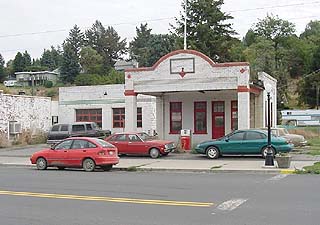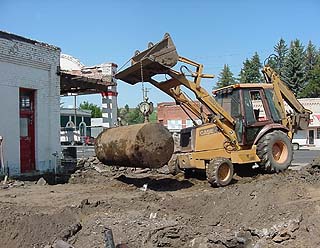
Surveys
DJC.COM
July 17, 2003
Brownfields program is here to stay
Department of Ecology


Photos courtesy of Department of Ecology
The city of Rosalia was recently awarded one of three EPA underground storage tank field grants in Washington state. The petroleum contamination will be removed, the original 80-year-old brick gas station restored, and the site redeveloped into a visitor and community center.
|
It’s not just a passing phrase, whim, or jargon of the 1990s. As the U.S. government prepares to grant over $130 million to states, tribes, local governments and non-profits to investigate and clean up these properties, it is evident that brownfields cleanups are here to stay.
Brownfields are abandoned, idled or underused properties where redevelopment, business expansion, or other beneficial reuse is complicated by real or perceived environmental contamination. They gained their title in the early 1990s when over 600,000 properties across the nation were deemed “blights on the landscape.”
Once productive community assets, these properties — abandoned gas stations, dilapidated buildings — were now seen as liabilities. Municipalities, lenders and developers were afraid that involvement with these sites would make them liable for cleaning up contamination they did not create. Consequently, banks were less willing to lend money, insurance companies were apprehensive in providing coverage, and developers began seeking out pristine “greenfield” properties instead.
To address this growing concern, the Environmental Protection Agency began offering financial assistance and incentives to states, local communities and the private sector to address brownfield properties.
Since its inception in 1993, the brownfields program has provided over $230 million in grants with $4.6 billion leveraged and over 11,000 jobs created. This includes 176 new grants for $73 million announced June 20, 2003.
Examples in Washington state include:
- $11 million awarded to cities, counties, ports and tribes to investigate or clean up brownfield sites in their communities, including nine grants for $4.6 million announced in June 20.
- The Duwamish industrial corridor — the most highly concentrated industrial area in our state — was selected as one of 16 nationwide showcases and received over $1 million to identify projects to address brownfields redevelopment. Three projects are being implemented by the King County/Seattle Brownfields Program: an environmental extension service, a hydrogeologic pathways study for the Duwamish industrial corridor, and an advisory group to develop statewide risk-based standards for cleaning up total petroleum hydrocarbons.
- King County/City of Seattle, the city of Tacoma and the Colville Reservations received nearly $600,000 to develop training programs. In King County, 57 graduates that completed a 5-week training program were placed in environmental jobs.
- The cities of Rosalia, Seattle and Tacoma received over $230,000 to remove underground storage tanks and residual contamination.
- The cities of Tacoma, Spokane and Seattle, along with King County and rural counties, received $5.3 million to establish a revolving loan fund. King County and the city of Seattle plan to target manufacturing and industrial centers, in particular the Duwamish corridor. Within Tacoma, the target areas are downtown, the South Tacoma industrial area and the Port of Tacoma.
- The city of Port Townsend received $1 million to help finance development of the Port Townsend Northwest Maritime Center.
The Department of Ecology’s Voluntary Cleanup Program oversees the investigation and cleanup work at many of these sites. Implemented in 1997, Ecology staff review cleanup reports and provide a written decision for a fee. To date, the program has overseen nearly 1,800 sites and provided “no further action” decisions to over half. The remaining sites are still in the review process or require more work.
| Brownfields help |
|
The King County/Seattle Brownfields Program offers an environmental extension service that provides free, confidential technical assistance to individual brownfield projects by conducting assessments and linking projects to additional federal, state and local financial and technical assistance programs. Over the last two years, the service has contacted nearly 2,000 businesses, completed 32 assessments, assessed over 75 acres, saved businesses $253,500 in technical assistance and other costs, and leveraged $2.5 million in private sector assessments and cleanups. For more information, to go http://dnr.metrokc.gov/swd/Brownfields/technical.shtml.
|
Brownfield revitalization and redevelopment, however, is just reaching its momentum. Last year, President Bush signed into law the Small Business Liability Relief and Brownfields Revitalization Act which expands federal assistance for brownfield revitalization. This new law increased brownfields funding and expanded the types of grants and sites EPA funds can address, including the authority to make direct cleanup grants and to award funds to address sites contaminated by controlled substances — such as private homes used as drug labs, low-risk petroleum-contaminated sites and mine-scarred lands such as abandoned coal mines or smelters.
The law also limits liability, clarifies innocent landowner defenses and provides increased grants to states and tribes for their response programs.
You can learn more about brownfields and the funding that’s available for revitalization and redevelopment at the free Oct. 27-29 Brownfields Conference in Portland.
Cosponsored by the EPA and International City/County Management Association, the conference will provide an opportunity for those interested in brownfields redevelopment. Participants will share their experiences with each other, learn from experts, see the latest products and services, and hear success stories and innovative new ideas from around the world. Last year, 3,200 people attended.
For registration information, go to www.brownfields2003.org.
Sherrie Minnick is voluntary cleanup program coordinator for the Washington Department of Ecology in Lacey.
Other Stories:
- Battle over keeping dams rages on
- What’s your vision for Seattle’s future?
- Hat Island gets a drink from the sea
- Foss Waterway cleanup kicks into high gear
- Reclaimed water — a ‘new’ water supply
- LOTT dives into reclaimed water
- Clean air: saving our competitive advantage
- Europe points the way to sustainability
- Old maps handy for site investigations
- Planning for an environmental emergency
- Engineered logjams: salvation for salmon
- Pierce County maps where its rivers move
- Be prepared with a spill management plan
- Development can be beneficial to wetlands
- Check out properties with microbial surveys
- Charting a sustainable course for the Sound
- Water rights no longer a hidden asset
- The economics of sustainability
- Laying the path for responsible education
- Squeezing more out of renewable energy
- Controlling mosquitos and the environment
- Beavers back in force in the Seattle area
- Our future: no time or resources to waste
- Port Townsend dock promotes fish habitat
- Master Builders teaches green homebuilding
- Sculpting a park out of a brownfield
- A salmon-friendly solution on the Snake
Copyright ©2009 Seattle Daily Journal and DJC.COM.
Comments? Questions? Contact us.